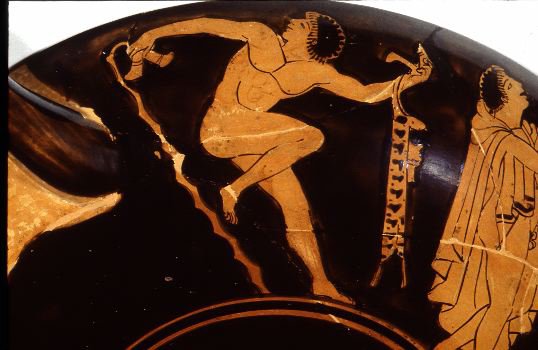The Stymphalian Birds
After Hercules returned from his success in the Augean stables, Eurystheus came up with an even more difficult task. For the sixth Labor, Hercules was to drive away an enormous flock of birds which gathered at a lake near the town of Stymphalos.
Arriving at the lake, which was deep in the woods, Hercules had no idea how to drive the huge gathering of birds away. The goddess Athena came to his aid, providing a pair of bronze krotala, noisemaking clappers similar to castanets. These were no ordinary noisemakers. They had been made by an immortal craftsman, Hephaistos, the god of the forge.

Dancer with krotala, flute case, and walking stick
Philadelphia MS2445, Attic red figure kylix, ca. 480 B.C.
Photograph by Maria Daniels, courtesy of the University of Pennsylvania Museum
Climbing a nearby mountain, Hercules clashed the krotala loudly, scaring the birds out of the trees, then shot them with bow and arrow, or possibly with a slingshot, as they took flight.

Hercules and the Stymphalian birds
London B 163, Attic black figure amphora, ca. 560-530 B.C.
Photograph courtesy of the Trustees of the British Museum, London
Some versions of the legend say that these Stymphalian birds were vicious man-eaters. The 2nd century A.D. travel writer, Pausanias, trying to discover what kind of birds they might have been, wrote that during his time a type of bird from the Arabian desert was called "Stymphalian," describing them as equal to lions or leopards in their fierceness. He speculated that the birds Hercules encountered in the legend were similar to these Arabian birds.
|
These fly against those who come to hunt them, wounding and killing them with their beaks. All armor of bronze or iron that men wear is pierced by the birds; but if they weave a garment of thick cork, the beaks of the Stymphalian birds are caught in the cork garment... These birds are of the size of a crane, and are like the ibis, but their beaks are more powerful, and not crooked like that of the ibis.
Pausanias, Description of Greece, 8.22.5 |
Pausanias also saw and described the religious sanctuary built by the Greeks of Stymphalos and dedicated to the goddess Artemis. He reported that the temple had carvings of the Stymphalian birds up near its roof. Standing behind the temple, he saw marble statues of maidens with the legs of birds.
(md)
To read more about these topics, see Further Resources.
- Labor 1: The Nemean Lion
- Labor 2: The Lernean Hydra
- Labor 3: The Hind of Ceryneia
- Labor 4: The Erymanthean Boar
- Labor 5: The Augean Stables
- Labor 6: The Stymphalian Birds
- Labor 7: The Cretan Bull
- Labor 8: The Horses of Diomedes
- Labor 9: The Belt of Hippolyte
- Labor 10: Geryon's Cattle
- Labor 11: The Apples of the Hesperides
- Labor 12: Cerberus
This exhibit is a subset of materials from the Perseus Project database and is copyrighted. Please send us your comments.